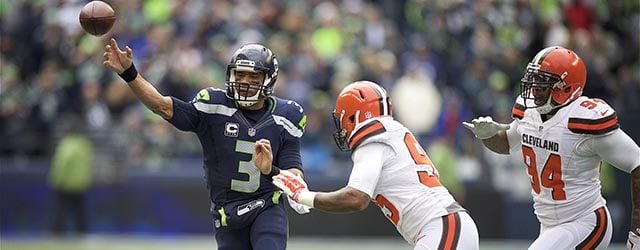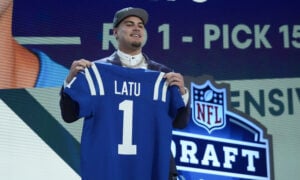Super-Flex 101: Building the Foundation
 This article is written by new Member Corner writer, Adam Bendzick. In this multi-part series, Adam will dive into the growing popularity of the Super-Flex (2QB) format and how to leverage available information to build a competitive team. We welcome Adam to our Member Corner and look forward to seeing more of his work in the future. We hope you’ll give him feedback!
This article is written by new Member Corner writer, Adam Bendzick. In this multi-part series, Adam will dive into the growing popularity of the Super-Flex (2QB) format and how to leverage available information to build a competitive team. We welcome Adam to our Member Corner and look forward to seeing more of his work in the future. We hope you’ll give him feedback!
“There’s no such thing as a sure thing. At the end of the day, the only thing that matters is what you think.” (Draft Day). Isn’t this quote the very essence of fantasy football in general? We obviously can’t predict the future, but we certainly can at least attempt to minimize risk. In the off season our teams are built around upside. But during the season that upside needs to materialize into a consistent week to week scoring potential.
In the first installment of this series I would like to offer general guidance that will help you in your dynasty leagues. Although this information could help you in all leagues, my primary focus will be geared towards 2QB leagues or super-flex leagues. These types of leagues have grown in popularity tremendously over the last few years. I believe they will become the most popular league in the near future and I want to help you stay ahead of your competition.
In 2015, owners are putting their primary focus on the wide receiver position. In general, most managers are spending their assets in an attempt to acquire a handful of WR1 type talents to build their teams around. While that makes complete sense because wide receivers typically have lengthy careers, is that truly the best place to build the foundation of your franchise? When we take a look at prior year’s data the numbers might surprise you. Those players that you expect to be perennial top tier talents, might not consistently come from the wide receiver position.
Looking back at data from 2012 through 2014 we can gain a good sense of the players that we can expect to be long term assets. These players will become the foundation of our roster. Based on total points scored from 2012 through 2014, only two wide receivers finished as WR1’s in each respective season in a standard one point per reception 12 team league. Those guys are the elite level talents named Dez Bryant and Demaryius Thomas. While other wide receivers had consistently good seasons, there were a total of 24 different names that bested the list from 2012 through 2014. As the 2015 season progresses, both Dez and Demaryius are in danger of falling off of that list.
The only running backs that managed to make the RB1 list in every season from 2012 through 2014 are Marshawn Lynch and Jamaal Charles. Both of those once highly coveted running backs will drop off of that list in 2015. For the tight end position, Jason Witten, Jimmy Graham, Greg Olsen, and Martellus Bennett all finished 2012 through 2014 as TE1’s. While these top tight end options produce consistent numbers year in and year out, most owners refrain from putting a large amount of stock into the tight end position. Due to scoring setups, typically tight ends will not produce the same volume of points as quarterbacks, running backs, and wide receivers. Unless you are playing in a tight end premium league, there isn’t a ton of upside to building your foundation around the tight end position. Rob Gronkowski might be your only exception to this rule.
So what position should you be building your foundation around? In a 2QB or super-flex league, there is no doubt your team should be built around the NFL signal callers. From 2012 through 2014, five quarterbacks finished with QB1 level numbers in all three seasons. Two of those players are on pace to finish as QB1’s again in 2015. Drew Brees is one of the names, and Russell Wilson is the other. Interestingly enough though, if we include the current data from 2015, 10 quarterbacks have finished as top tier options in three out of the last four seasons.
Drew Brees and Russell Wilson are perfect examples of what can be gained by investing into the QB position early in developing the foundation of your roster. If your league only starts one quarterback, by rostering Brees you have been able to count on him as your perennial starter for the past ten plus seasons. Not only do you more often than not gain a weekly advantage over your opponent, you also gain a year to year advantage. While others attempt to stream options and acquire stop gap signal callers, Brees has been locked into your lineup. While others are trying to match that QB1 level production, you can then start building around Brees and spend all of your draft picks and free agent money on building your other positions. Current owners of Russell Wilson probably will not have to put any other stock into the quarterback position for eight or more years.
In 2QB leagues, the need to build your foundation around the quarterback position is significantly magnified. If you have two top tier QB1 level producers, you are almost instantly a playoff contender. Unless you manage your other assets poorly, you can almost certainly surround your coveted signal callers with cheaper veteran producers that can help you win a championship. Earlier in the year, a guy like Eric Decker could be acquired for a second round draft pick in a 2QB league. In weeks that both players have played, Decker has outscored A.J. Green six out of eleven times. You can often find cheap options like that over the course of the season at the wide receiver position, but there is no chance of acquiring a quality near QB1 level producer on the cheap ever in a 2QB league. If your foundation of quarterbacks is solid, the rest of your dynasty will become much easier to assemble.
This is only my first installment into this series, and I just wanted to give you a taste of what to expect. Over the next few weeks, I am planning on having individual articles geared specifically toward the quarterback position and how to build up the position as your primary asset. I will be addressing the veterans and their value, as well as rookies and their impact on 2QB leagues. We will review some potential off season trade targets, and also the importance of stashing young quarterback prospects.
Please feel free to leave feedback in the comments section. I look forward to hearing from you.


































































